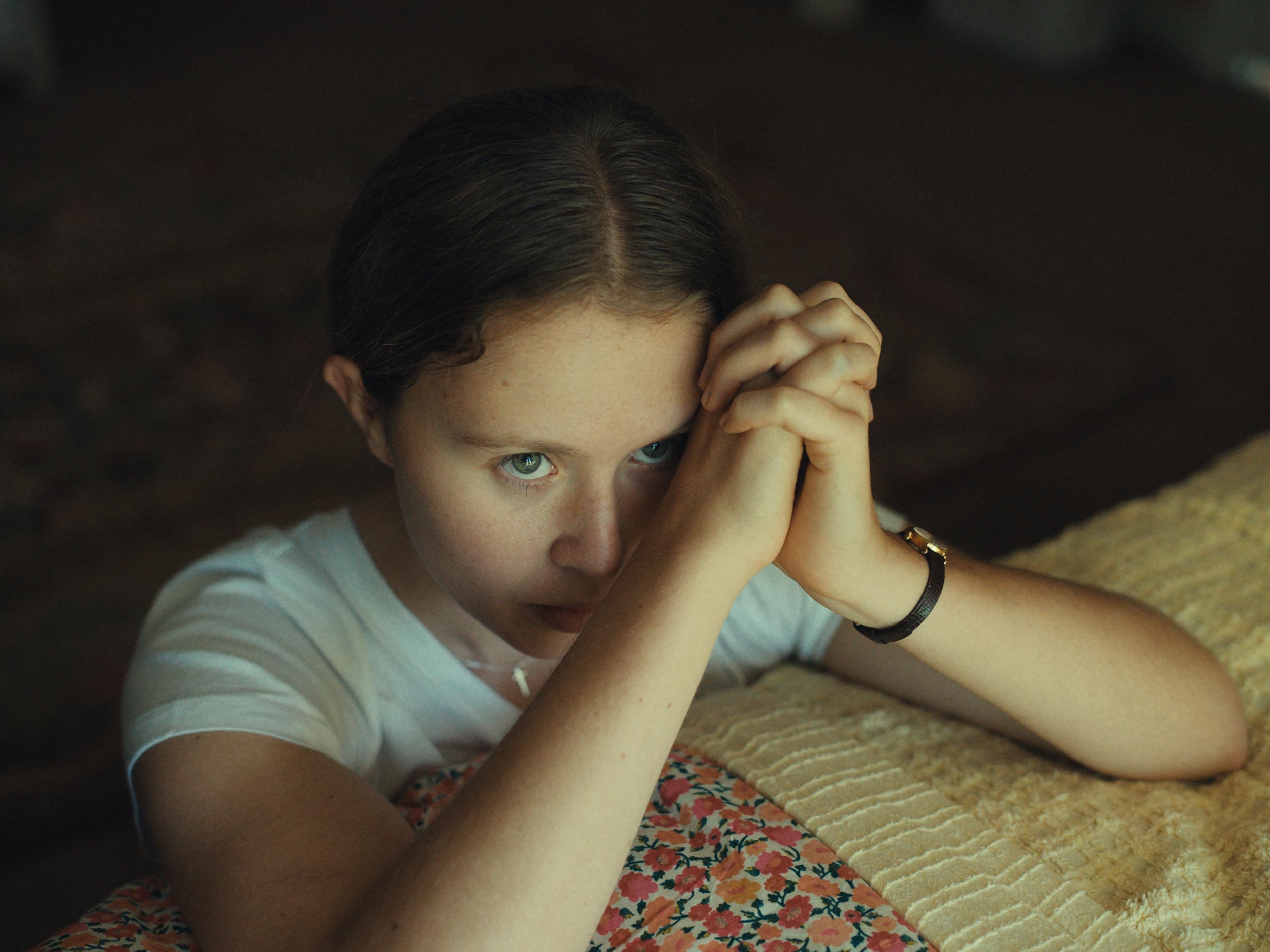Upon the streaming release of her debut film, Laurel Parmet sits down with Document to discuss the coexistence of faith and desire
Jem Starling practices a worship dance in the dark. The choreography is slow and deliberate: The 17-year-old extends her arms above her head, reaching for something unseen in the twilight sky, her eyes clear and full of conviction. Laurel Parmet’s The Starling Girl is a film about Jem’s relationship with Owen Taylor, her magnetic, much older youth pastor. But, as this scene reminds us, there is another connection central to the picture: Jem’s relationship with God.
As a member of a fundamentalist Christian community, Jem is taught to empty herself of ego. We see her aspire to abnegation while simultaneously chafing against the restrictions of her religion: She cries when an older woman chastises her for letting the outline of her bra show through her dress, and she is reluctant to enter a church-sanctioned courtship with an awkward, acne-prone boy her age. Owen—who smokes cigarettes after church service and dreams of returning to Puerto Rico, where he previously served as a missionary—brings an alternative conception of God to his cloistered community. He blurs the line between the sacred and the sensual, intoxicating Jem in the process.
Parmet decided to set her film in a Christian community after interviewing women from a patriarchal church in Oklahoma while conducting research for a separate project. She was surprised to see that the women’s beliefs reflected a more mainstream national culture.“We live in a country that’s very much affected by conservative Christian thought,” she observes. “I wanted to understand that world better since it literally affects me and my body. In doing so, I ended up finding a tremendous amount of admiration for faith.”
The women’s experiences also resonated with Parmet on a more personal level. “I had—for lack of a better term right now—a relationship with an older man when I was teenager,” she explains. “After it ended, I had a lot of guilt about it, but then I really did push those feelings aside, and I didn’t think about it for a while.”
The conversations that Parmet had in Oklahoma caused her to reevaluate her own experiences. “It made me question why I felt guilty about this scenario, when he was really taking advantage of me. Where did I learn to experience that guilt?”
In making The Starling Girl, Parmet was committed to emphasizing the complexity of Jem’s situation. “Without a doubt, there are cases of abuse that are very black-and-white,” she says. “But there are also many cases where it is more nuanced.” Over the course of the film, we see Jem actively pursue Owen: asking him for rides home from church, biking to his house to talk about her dance troupe. But Parmet doesn’t let the audience forget that Owen is the one in a position of power: One sexually-charged scene in the woods is undercut by the fact that Jem is wearing a baggy, bright yellow t-shirt with the name of her youth group printed across the front.
Even as Owen lures Jem into an intense and isolating sexual relationship, Parmet refrains from casting him as the villain. “I didn’t want to have him be this obvious predator,” she explains. “I just think that’s boring filmmaking. I, as an audience member, prefer to watch films where my ideas about a character are changing. That is when I feel the most engaged.”
“It was important for the audience to understand that he is lost, and that he is searching,” she adds. “It doesn’t excuse his behavior—but it helps to humanize him.” At some points in the film, it is difficult to tell if Owen’s proclamations are genuine, or merely a ruse to get Jem into bed with him. Parmet explains that this uncertainty is the point: The audience’s feelings are meant to mirror Jem’s own.
“The film is told a hundred percent through Jem’s eyes,” she says. “The audience is experiencing what she’s experiencing, and feeling what she’s feeling.” Every creative decision that went into The Starling Girl was centered around what Parmet calls a ‘studied nonchalance’—not emphasizing any particular moment over another, to help audiences reserve judgment and remain close to Jem’s perspective.
“The film isn’t meant to say, Fuck God. We wanted to offer a more complex look at religion and its states, and to suggest that there are many ways to connect with God.”
The lushness of the film’s visuals reflects the way that Jem sees her surroundings. “It’s a world that’s full of possibility, romance, and danger,” says Parmet. “I wanted to create something that was dreamy.” The landscapes of The Starling Girl—the light-filled rooms of Jem’s church, the cake-yellow walls of her house, the velvety green creek she swims in for solace—are meant to feel “familiar and inviting.”
Parmet’s insistence upon showcasing the beauty of the film’s setting is a welcome departure from stories that represent religion as something that is strictly repressive and arcane. She was conscious of these stereotypes going into the project, and she strove for delicacy throughout the filmmaking process. “The film isn’t meant to say, Fuck God,” Parmet says. “We wanted to offer a more complex look at religion and its states, and to suggest that there are many ways to connect with God.”
The Starling Girl ends on another scene of worship dance. This time, Jem’s movements are more joyous, but her conviction remains intact. “She never loses her faith,” says Parmet. “She never loses her connection with God. If anything, her relationship with God strengthens over the course of the film, because she’s starting to define that for herself.”
“Maybe God lives in Jem’s questions,” Parmet posits. “In her desires, in everything that she experiences; in the mistakes that she makes, and in growing from those mistakes. She learns that can be a divine gift as well.”











